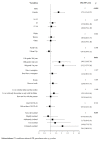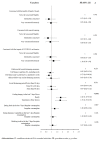Depressive Symptoms and Their Associated Factors in Vocational-Technical School Students during the COVID-19 Pandemic
- PMID: 35329421
- PMCID: PMC8955985
- DOI: 10.3390/ijerph19063735
Depressive Symptoms and Their Associated Factors in Vocational-Technical School Students during the COVID-19 Pandemic
Abstract
The objectives of this study were to compare the prevalence of depressive symptoms, behavioral habits, and QoL in students from two vocational-technical schools, and to determine the association of depressive symptoms with behavioral habits and quality of life (QoL) in these students during the COVID-19 pandemic. A cross-sectional survey was conducted with students attending the institution of the Brazilian Federal Network of Professional, Scientific and Technological Education. The students answered a questionnaire on sociodemographic variables, situations related to the COVID-19 pandemic, behavioral habits, QoL, and depressive symptoms. The outcome variable was the presence of depressive symptoms, assessed using the Children's Depression Inventory (CDI). Poisson regression analysis with robust variance was performed. A total of 343 students participated in this study (women, 55.7%; mean age of 16.1 ± 0.93 years). The prevalence of depressive symptoms among students was 43.4% (95% confidence interval [CI]: 38.0-49.0), and these symptoms were significantly associated with being female (prevalence ratio [PR] 1.72; 95% CI: 1.31-2.27); being in the 10th grade (PR: 1.80; 95% CI: 1.18-2.76) and 9th grade (PR 2.08; 95% CI: 1.37-3.18); social isolation (PR: 2.04; 95% CI: 1.00-4.14); hunger due to a lack of food at home (PR: 1.78; 95% CI: 1.33-2.39); low physical activity levels (PR: 1.68; 95% CI: 1.09-2.59); and moderate (PR: 2.87, 95% CI: 1.68-4.89) and low QoL (PR: 5.66; 95% CI: 3.48-9.19). The results emphasize the importance of interventions aimed mainly at female students and those in the initial years of high school, in addition to the importance of physical activity, food safety, and QoL to improve the mental health of students.
Keywords: COVID-19; adolescents; depression; mental health; quality of life.
Conflict of interest statement
The authors declare no conflict of interest.
Figures




References
-
- Chen X., Qi H., Liu R., Feng Y., Li W., Xiang M., Cheung T., Jackson T., Wang G., Xiang Y.T. Depression, anxiety and associated factors among Chinese adolescents during the COVID-19 outbreak: A comparison of two cross-sectional studies. Transl. Psychiatry. 2021;11:148. doi: 10.1038/s41398-021-01271-4. - DOI - PMC - PubMed
-
- Nagy-Pénzes G., Vincze F., Bíró É. Contributing factors in adolescents’ mental well-being—the role of socioeconomic status, social support, and health behavior. Sustainability. 2020;12:9597. doi: 10.3390/su12229597. - DOI
MeSH terms
LinkOut - more resources
Full Text Sources
Medical
Research Materials

